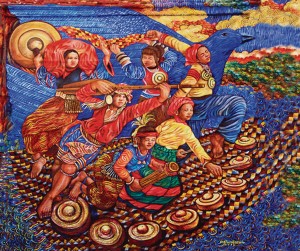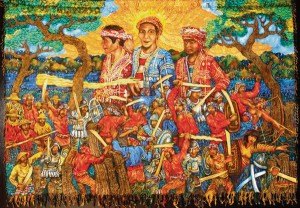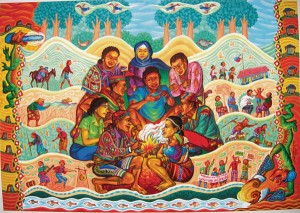Visualizing the plight of the Philippine Indigenous People
Visualizing the plight of the Philippine Indigenous People
The Country in the Heart
By Ed Maranan
The National Indigenous People’s Month in the Philippines, which is October, passed with hardly a milestone achieved in the age-old struggle to uplift the lives of millions of these descendants of the original inhabitants of our archipelago. Instead, the highlight of the month was the grisly massacre of a B’laan family in Tampakan, Cotabato, as an offshoot of this group’s resistance against the threat of destruction posed by the mining project of Xstrata-SMI.
In 1997, Republic Act 8371 or the Indigenous People’s Rights Act (IPRA), was enacted to recognize, protect and promote the rights of the country’s numerous “cultural communities” (who used to be called “national minorities” or “tribal groups”)—the indigenous people who have managed to hold on to or defend their remaining ancestral domains, from the Cordillera of northern Luzon’s Kaigorotan (people of the mountains) down to the hills, hinterlands and ranges of Mindanao’s Lumad (natives of the land). To this day, the long-festering problems of food security, health and education, rights to ancestral land and the natural resources therein, and the right to self-determination of the IP still remain basically unresolved.
On October 15 this year, the nation was appalled by the latest terror to be visited on the IPs of Mindanao. Juvy Capion, a pregnant B’laan woman, and her two sons were mowed down at close range by elements of the 20th Infantry Battalion in Tampakan, South Cotabato. The military was hunting down the head of the family, the B’laan leader Daguil Capion. I was listening to a live remote interview of Daguil Capion on DZXL the day after the massacre. He was speaking from a place of refuge, and his voice clearly showed the stress and suffering of a hunted man whose family had just been wiped out. He belied the military’s claims that he was in the house when the massacre happened, that the soldiers only strafed the house because he had fired first. It was true he was leading the armed resistance of the B’laans against destructive mining to which the government had turned a blind eye, but there was no firefight, he said, and his family had been deliberately targeted out of spite.
Over the years, the oppression and dehumanization of Philippine IPs have been denounced by pro-IP advocates and activists like Katribu, Tabak, Kampi, Legal Rights and Natural Resources Center, Inc., Kasama sa Kalikasan and Friends of the Earth; dirged about by performing artists like Joey Ayala and Bagong Lumad; and depicted by visual artists like Bert Monterona and Federico Boyd Dominguez.
In Dominguez’s work entitled Land Grab, the subject is the world’s indigenous and marginalized people. It is a grim portrayal of the common fate of mountain communities as well as traditional peasant societies particularly in the Third World, who have to contend with the encroachment of national as well as global capital. The conversion of huge swathes of the Amazon rainforest into pasture land for the cattle industry, and the entry of extractive industries in other parts of the continent, bear similarities to the conversion of Mindanao Lumad lands into plantations, forests into logging concessions, and the destruction of native habitat due to mining activities, as in Sumitomo’s Taganito mines in Davao.
One is reminded of the top-grossing film “Avatar” by James Cameron, a sci-fi tale set in the distant future about a mythical inhabited moon called Pandora, where the Na’vi IP are threatened by an interplanetary (read multinational) mining company wanting to deploy its earth-moving and digging machines to extract ‘unobtanium’, which lies underneath the mystical Hometree of the natives. Land Grab, gouache on watercolor paper, was done by Dominguez in 2011, to celebrate International World’s Indigenous Peoples’ Day on August 9, and was commissioned by Routledge/Taylor & Francis Publication of Canada.
The murals and other large-scale works of Vancouver-based Bert Monterona are dramatic evocations of the struggles and aspirations of the Lumad of Mindanao. Even when dealing with other themes on his canvas, all of his works, according to him, “whatever their forms and motives, reflect the magical ritualism of (his) rich indigenous roots…in an intoxicating mixture of color, figures, symbols and motifs…”
His 4-square-meter tapestry painting Historical Struggle is a tableau sweeping across centuries of resistance against colonialism, personified by the sword-wielding armored soldiers of the Spanish conquest, with the tree stumps on the landscape contrasted with the remaining sturdy ‘hometrees’ of the ancestral domain symbolizing a more contemporary conflict across the vastness of Mindanao.
Both artists, though, have hopeful visions for the future of the Indigenous people of this country. In his work Culture of Peace (one of two works the artist lost recently to a snatcher in Vancouver), Monterona showcases the wealth of Lumad cultural heritage: a colorful mat serves as a flying carpet (echoing the sinalimba, the Subanen’s mythical vessel) which bears aloft two dancers and four musicians playing the agung, the hegalong, the sigitan or kudlong (kulitong in northern Luzon), and the kulintang. A giant bird, symbol of peace, takes up the background.
In one of several paintings entitled Talabok—a Matigsalog word which means gathering (for storytelling), feasting, or market day—Dominguez rhapsodizes on the ‘intertribal’ idyll, bringing together representatives of various IP groups in the Philippines, even including a sectoral figure from civil society, as they engage in animated consultation around a fire, surrounded by images of a peaceful, progressive nation where culture, livelihood, education, family and community life, and human rights are vibrant, while relegated to the margins, perhaps even to a grim past, are images of the busaw (evil spirits), portrayed as reptilians, with one having a chainsaw for a tongue and another with bulldozers for hands.
Still and all, the most memorable if harrowing images about the Philippines’ indigenous people during the month of October, indeed this year, were the pictures of the massacred members of the B’laan Capion family, the pregnant Juvy shot through the chest, 8-year-old John with his head blasted open (mother and son slain while in tearful embrace), and 13-year-old Jordan with a bullet through the back of his head.






Comments (3)
Categories